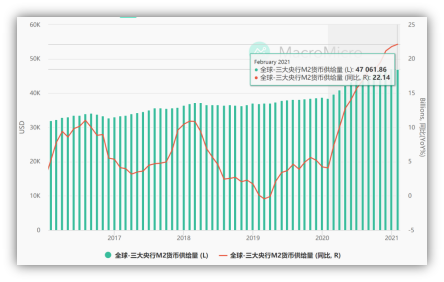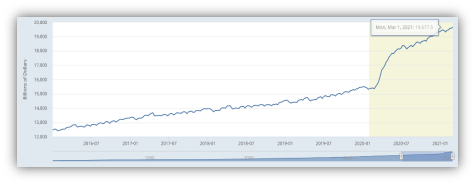Alert! "Stagflation" in international trade may strike
No.1┃ Crazy raw material prices
Since 2021, commodities have "rised". In the first quarter, a total of 189 commodities rose and fell in the commodity price list. Among them, 79 commodities increased by more than 20%, 11 commodities increased by more than 50%, and 2 commodities increased by more than 100%, involving energy, chemicals, non-ferrous metals, steel, rubber and plastics and agricultural products and other fields.
The rise in commodity prices directly pushed up the purchase price of product raw materials. In March, the purchase price index of major raw materials approached 67%, which has been higher than 60.0% for four consecutive months and hit a four-year high. Construction timber has also seen an increase of about 15% to 20%, which is evident in the cost pressure.
Against the backdrop of the new crown epidemic, major global economies have implemented large-scale monetary easing policies. As of the end of February 2021, the M2 broad money supply of the three major central banks in the United States, Europe and Japan exceeded US$47 trillion. This year, the United States has introduced a stimulus package of US$1.9 trillion and a large-scale infrastructure plan of more than US$1 trillion. As of March 1, the amount of M2 in the United States reached US$19.7 trillion, a year-on-year increase of 27%. The continuous injection of liquidity into the market directly pushes up the prices of bulk commodities, and the epidemic has reduced global production, and some commodities are in short supply, which has exacerbated price increases.
Figure 1: M2 money supply of the world’s three major central banks

Figure 2: U.S. M2 money supply

No.2┃Construction industry demand or high decline
Faced with rising raw material prices, Sampmax Construction had to increase prices "on the market". But the extreme sensitivity of overseas buyers to price increases puts companies in a dilemma. On the one hand, there will be no profit margins if there is no price increase. On the other hand, they are worried about the loss of orders after the price increase.
From a macro perspective, excessively loose monetary policy is difficult to stimulate new demand, but may lead to inflation and excessive debt leverage. The game of international trade stock is superimposed on the gradual recovery of overseas production capacity, and the substitution effect is declining, making it difficult for overseas demand to maintain high levels.
No.3┃The hidden worries of "stagflation" in international trade
Stagflation is often used to describe the coexistence of stagnant economic development and inflation. Comparing this to international trade, foreign trade companies are forced to "involve" reluctantly when the price of raw materials and other costs have risen too high, while external demand has not increased significantly or even declined.
The epidemic of the century has caused a widening gap between the rich and the poor globally, the number of low-income classes has risen, the size of the middle class has fallen, and the trend of demand decline is obvious. This has brought about changes in the export market structure, that is, the mid-end market has fallen and the low-end market has risen.
The contradiction between supply-side inflation and demand-side deflation suppressed exports. With the downgrade of foreign consumption, the terminal market is extremely sensitive to export prices. The sharply rising export costs of many industries are difficult to pass on to foreign buyers and consumers by raising export prices.
In other words, the overall trade volume is still rising, but the booming figures have not brought more profits to our enterprises, nor have they been able to form continuous terminal demand. "Stagflation" is quietly coming.
No.4┃ Challenges and Responses to Trade Decision-making
Stagflation brings us not only a reduction in profits, but also challenges and risks in trade decisions.
In order to lock in prices, more and more overseas buyers tend to sign long-term agreements with us or place multiple orders and large orders at once. In the face of "hot potato", Sampmax Construction is in a dilemma again: it is worried about missing business opportunities, and it is also afraid that the price of raw materials will continue to rise after receiving the order, which will lead to failure to perform or lose money, especially for customers with small orders. The raw materials of our team are upstream. Bargaining power is limited.
In addition, based on the current prices are generally at a relatively high level, Sampmax Construction is ready to deal with price fluctuations. Especially in the market with violent price fluctuations, we will strictly control the collection conditions. At the same time, it is recommended that customers have order requirements to make quick decisions.
In view of the fact that Sampmax's customers check inventory and sales in a timely manner during the special period, it is recommended that our buyers closely follow up on the payment situation, adhere to the concept of security, carefully carry out large-value and long-term business, and be highly alert to large buyers , Intermediary risk. We will also discuss with you a longer-term cooperation plan.